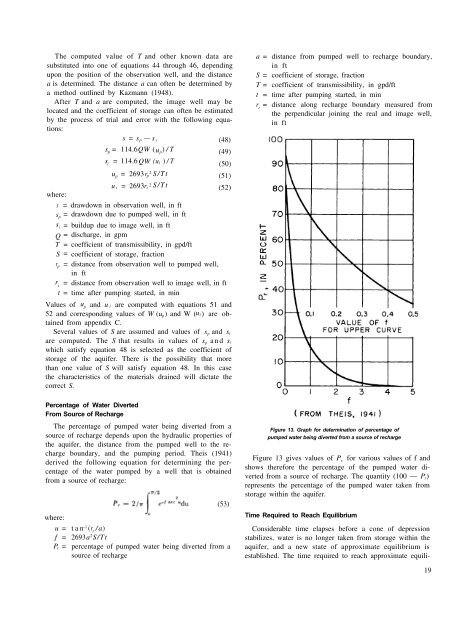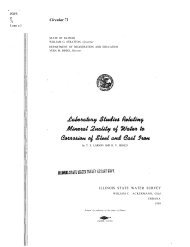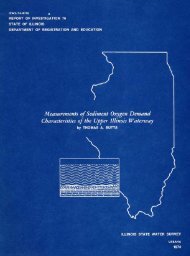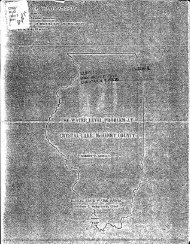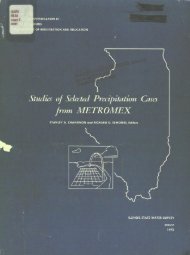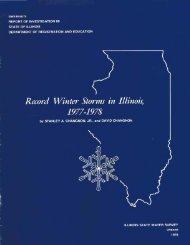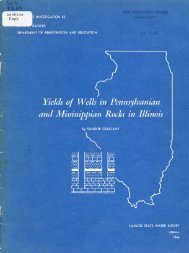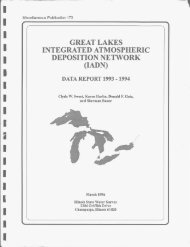Selected Analytical Methods for Well and Aquifer Evaluation
Selected Analytical Methods for Well and Aquifer Evaluation
Selected Analytical Methods for Well and Aquifer Evaluation
Create successful ePaper yourself
Turn your PDF publications into a flip-book with our unique Google optimized e-Paper software.
The computed value of T <strong>and</strong> other known data aresubstituted into one of equations 44 through 46, dependingupon the position of the observation well, <strong>and</strong> the distancea is determined. The distance a can often be determined bya method outlined by Kazmann (1948).After T <strong>and</strong> a are computed, the image well may belocated <strong>and</strong> the coefficient of storage can often be estimatedby the process of trial <strong>and</strong> error with the following equations:s=s p — s i (48)s p = 114.6QW (u p) / T (49)si = 114.6 QW (u i ) / T (50)u p = 2693r 2 p S/Tt (51)u i = 2693r2 i S/Tt (52)where:s = drawdown in observation well, in fts p= drawdown due to pumped well, in fts i = buildup due to image well, in ftQ = discharge, in gpmT = coefficient of transmissibility, in gpd/ftS = coefficient of storage, fractionr p = distance from observation well to pumped well,in ftri= distance from observation well to image well, in ftt = time after pumping started, in minValues of u p <strong>and</strong> u i are computed with equations 51 <strong>and</strong>52 <strong>and</strong> corresponding values of W (u p ) <strong>and</strong> W (u i) are obtainedfrom appendix C.Several values of S are assumed <strong>and</strong> values of s p <strong>and</strong> s iare computed. The S that results in values of s p <strong>and</strong> s iwhich satisfy equation 48 is selected as the coefficient ofstorage of the aquifer. There is the possibility that morethan one value of S will satisfy equation 48. In this casethe characteristics of the materials drained will dictate thecorrect S.Considerable time elapses be<strong>for</strong>e a cone of depressionstabilizes, water is no longer taken from storage within theaquifer, <strong>and</strong> a new state of approximate equilibrium isestablished. The time required to reach approximate equilia= distance from pumped well to recharge boundary,in ftS = coefficient of storage, fractionT = coefficient of transmissibility, in gpd/ftt = time after pumping started, in minr = distance along recharge boundary measured fromrthe perpendicular joining the real <strong>and</strong> image well,in ftPercentage of Water DivertedFrom Source of RechargeThe percentage of pumped water being diverted from asource of recharge depends upon the hydraulic properties ofthe aquifer, the distance from the pumped well to the rechargeboundary, <strong>and</strong> the pumping period. Theis (1941)derived the following equation <strong>for</strong> determining the percentageof the water pumped by a well that is obtainedfrom a source of recharge:(53)where:u = tan –l (rr/a)f = 2693a 2 S/TtP r = percentage of pumped water being diverted from asource of rechargeFigure 13. Graph <strong>for</strong> determination of percentage ofpumped water being diverted from a source of rechargeFigure 13 gives values of P r <strong>for</strong> various values of f <strong>and</strong>shows there<strong>for</strong>e the percentage of the pumped water divertedfrom a source of recharge. The quantity (100 — P r )represents the percentage of the pumped water taken fromstorage within the aquifer.Time Required to Reach Equilibrium19


